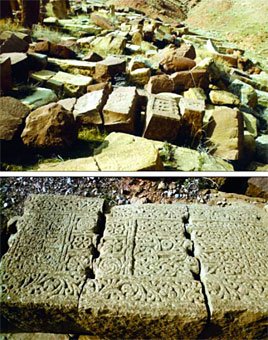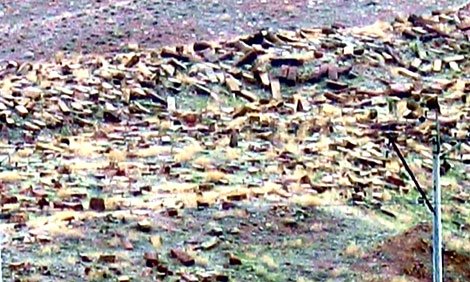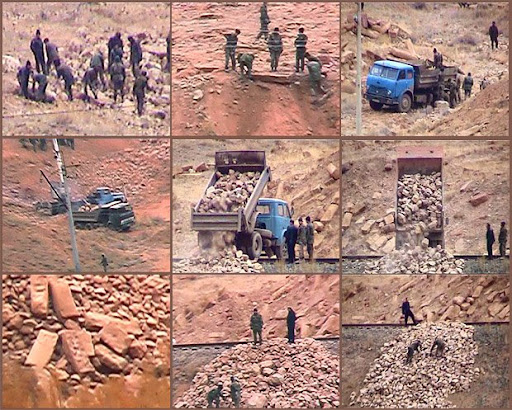The Nakhijevan Destruction (part II)
Khachkars broken to facilitate the process of destruction
Khachkars toppled and cemetery ready to be destroyed
On the wrong side of the Arax River and spread over three hills, the Jugha (Julfa) cemetery, could easily be seen from the Iranian side. This matchless human treasure included thousands of khachkars, ram-shaped gravestones and horizontally laid tombstones that were constructed in an era spanning from the ninth until the beginning of the seventeenth century AD when the expansion had stopped as a result of the forced migration of Armenians of the region to Iran. Some scholars believe the cemetery existed in an even earlier period.
This unique circumstance would allow the archaeologists to study the evolution of this craft and the diverse influences that were incorporated in their motifs as a result of the region’s location along the Silk Route. This alone made the historic site part of the heritage of all humankind.
Khachkar details and ram shaped tombstone
Visiting the cemetery in 1648, Alexandre de Rhodes reported of the existence of 10,000 khachkars and ram-shaped tombstones. Burning Jugha to cinders to cut supplies for the Ottoman army, Shah Abbas did not touch the cemetery and it was only under the Russian rule when almost half of the monuments were dismantled and used as construction material to build the nearby railroad in early twentieth century. Indeed, a Muslim king had far more consciousness, respect and appreciation of art and culture than the Christian Russian rulers.
The fate of the cemetery did not rouse much envy in the Soviet era either. Nakhijevan was treacherously appropriated by Armenian hating “Azerbaijan” and the Armenian monuments were neglected, used for other purposes at best or were regularly destroyed and the demolition was proudly announced to the Soviet authorities who had declared the religious monuments reminders of a reactionary society that merited to be pulled down. Of course a fake state that never had a history or a civilization did not have anything to lose, better still, they got rid of the evidence of millennia old Armenian presence and received praises from the Communist leaders.
While already in the 1930s no working churches remained in Artsakh, the Tatar occupiers had no problem praying in their mosques in Shushi. In the same manner several Islamic schools indoctrinated the Muslims in Yerevan mosques while the Armenian churches were being destroyed under the pretext of construction. For instance the opera house and Moscow movie theater are built on ground where ancient churches stood.
The early Turkic invaders used to reduce the ancient Amaras monastery - originally built by Gregory the Illuminator where about a century later Mesrop Mashtots had opened the first school in Artsakh - to rubble time and time again. Legend has it that they would line soldiers up from the site of the monastery to the Arax River who then passed the broken pieces and threw them into the river so that the Armenians would not be able to rebuild Amaras; but then again, the brave people of Artsakh would raise the monastery from its ruins. Having witnessed the monstrosity in Jugha in the 21st century, one may reconsider whether this was a true account rather than a legend.
A well known Turkish tradition: thousand year old human heritage turned to rubble and thrown into the Arax
Starting December 10, 2005, the genocidal “Azeri” squatters sledge-hammered the already toppled khachkars, loaded the pieces on trucks and emptied the load into the Arax River. Later, in March 2006, the “Azeris” poorly camouflaged the site by turning it into a shooting-ground, wiping this unparalleled example of human culture off the face of the earth, the same way they had exterminated the indigenous people who had created it.
Prime example of Turkish cultural creative process
Incapable of creation or even appreciation of human culture the “Azeri” Turks have turned the 1200 to 1500 year old Jugha cemetery into a pile of rubble to erase every piece of evidence of the presence of indigenous Armenians in Nakhijevan who the “Azeris” have managed to evict in front of the indifferent eyes of the “modern”, “civilized” world.
This barbarity is without doubt:
I. Cultural genocide.
II. Desecration of religious symbols.
III. Destruction of centuries old priceless heritage.
IV. Annihilation of unique works of a unique art form, not found among any other people.
V. Disrespect to the dead.
VI. A desperate attempt to eliminate all evidence of a horrendous crime.
VII. A despicable attempt to appropriate land that belongs to others.
VIII. A coward act of savagery by a group that claims to be part of humanity and civilization.
IX. The continuation of the Armenian Genocide.
X. The irrefutable proof of the Armenian Genocide.
“Azeri” genius: genocide thinly covered up. A shooting ground built too close to Iranian border to ever be used, in place of annihilated proof of Armenian ownership of Nakhijevan







0 Comments:
Post a Comment
<< Home